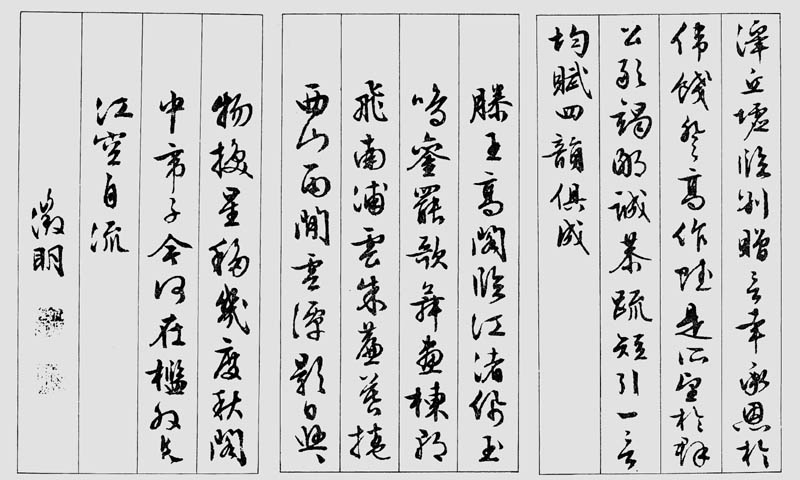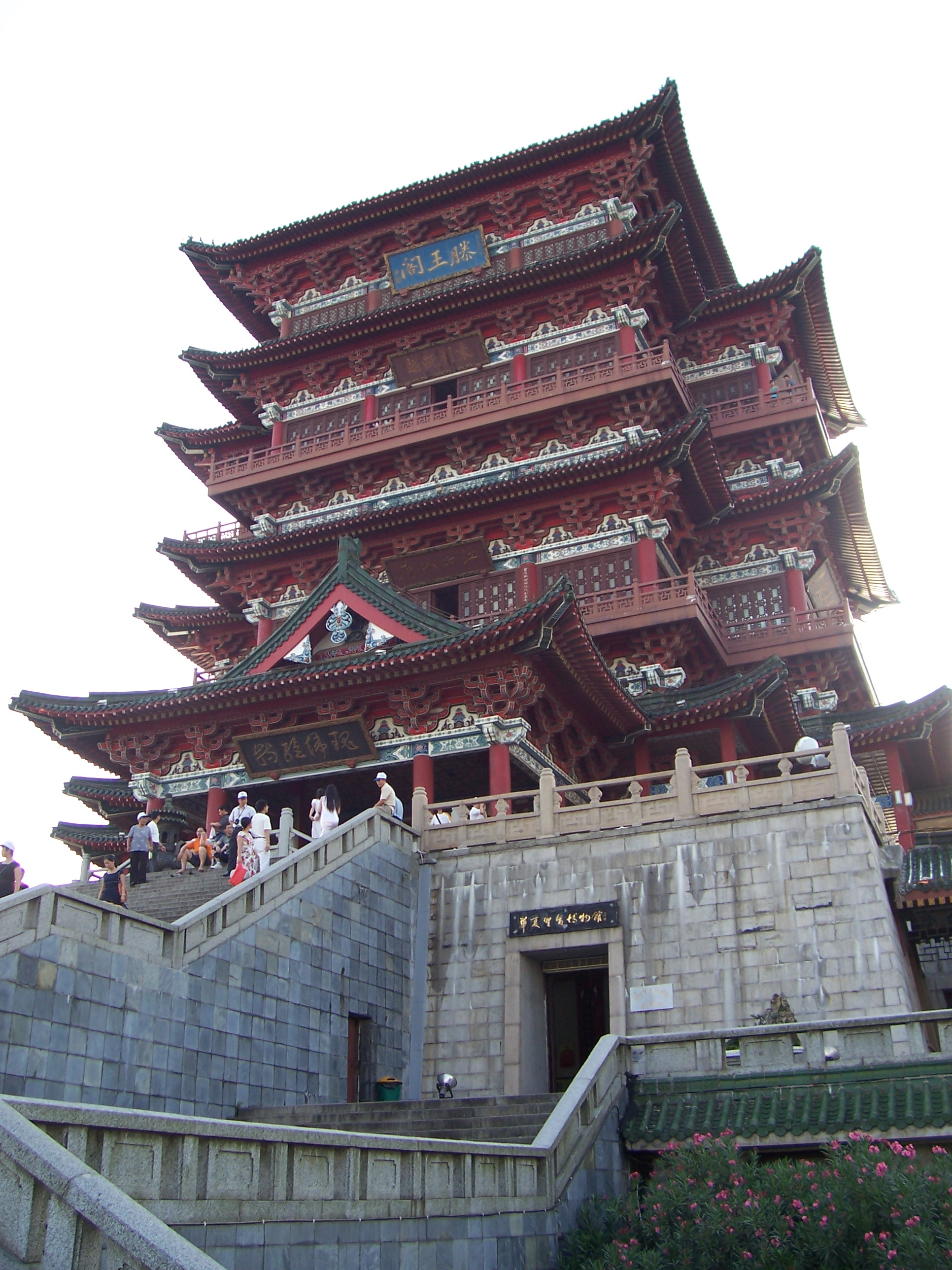|
Tengwang Ge Xu
''Tengwang Ge Xu'' (, ''Preface to the Prince Teng's Pavilion''), full name ''Preface to a Farewell Feast Atop the Prince Teng's Pavilion in Autumn'' () or ''Preface to Poems on the Prince of Teng's Pavilion'' (), is a piece of literature by Wang Bo of the Tang dynasty. It is considered a founding piece of Tang Literature. It is classified as Pianwen (), which depends greatly on rhythm, somewhat like classical Chinese poetry, but does not have a restriction of how many characters should be in one sentence, and how many sentences in one paragraph. It is named after Pavilion of Prince Teng, a pavilion standing by the Gan River of Nanchang City, which was then called Hongzhou () and is the capital of the current province of Jiangxi. It was first built in the early Tang dynasty. Wáng Bó was on his way to Jiaozhi County, in present-day northern Vietnam, visiting his father, and encountered a grand banquet held there. It is acknowledged that he actually finished the work at the ban ... [...More Info...] [...Related Items...] OR: [Wikipedia] [Google] [Baidu] |
Wang Bo (poet)
Wang Bo (; 650–676), courtesy name Zi'an (子安), was a Tang dynasty Chinese poet, traditionally grouped together with Luo Binwang Luo Binwang (, ca. 619–684?), courtesy name Guanguang (觀光/观光), was a Chinese poet of the Tang dynasty. His family was from Wuzhou, modern Yiwu, Zhejiang, but he was raised in Shandong. Luo is grouped with Lu Zhaolin, Wang Bo, and ..., Lu Zhaolin, and Yang Jiong as the Four Paragons of the Early Tang. He died at the age of 26, possibly from drowning, while going back from Jiaozhi (Vietnam, then under Tang rule) after meeting his father. He opposed the spread of the Gong Ti Style (宫体诗风) of the Sui Dynasty, and advocated a style rich in emotions. He was also famous for the essay ''Tengwang Ge Xu'', which is included in the Chinese middle school curriculum. Life Wang Bo was born in A.D 650 into a family with high literary status. His grandfather was the Sui dynasty Confucian philosopher Wang Tong (philosopher), Wang ... [...More Info...] [...Related Items...] OR: [Wikipedia] [Google] [Baidu] |
Tang Dynasty
The Tang dynasty (, ; zh, t= ), or Tang Empire, was an Dynasties in Chinese history, imperial dynasty of China that ruled from 618 to 907 AD, with an Zhou dynasty (690–705), interregnum between 690 and 705. It was preceded by the Sui dynasty and followed by the Five Dynasties and Ten Kingdoms period. Historians generally regard the Tang as a high point in Chinese civilization, and a Golden age (metaphor), golden age of cosmopolitan culture. Tang territory, acquired through the military campaigns of its early rulers, rivaled that of the Han dynasty. The House of Li, Lǐ family () founded the dynasty, seizing power during the decline and collapse of the Sui Empire and inaugurating a period of progress and stability in the first half of the dynasty's rule. The dynasty was formally interrupted during 690–705 when Empress Wu Zetian seized the throne, proclaiming the Zhou dynasty (690–705), Wu Zhou dynasty and becoming the only legitimate Chinese empress regnant. The devast ... [...More Info...] [...Related Items...] OR: [Wikipedia] [Google] [Baidu] |
Tang Poetry
Tang poetry () refers to poetry written in or around the time of or in the characteristic style of China's Tang dynasty, (June 18, 618 – June 4, 907, including the 690–705 reign of Wu Zetian) and/or follows a certain style, often considered as the Golden Age of Chinese poetry. The ''Quan Tangshi'' includes over 48,900 poems written by over 2,200 authors. During the Tang dynasty, poetry continued to be an important part of social life at all levels of society. Scholars were required to master poetry for the civil service exams, but the art was theoretically available to everyone. This led to a large record of poetry and poets, a partial record of which survives today. The two most famous poets of the period were Li Bai and Du Fu. Through the ''Three Hundred Tang Poems'', Tang poetry has remain familiar to educated Chinese in modern times. Periodization The periodization scheme employed in this article is the one detailed by the Ming dynasty scholar Gao Bing (1350–1423) in th ... [...More Info...] [...Related Items...] OR: [Wikipedia] [Google] [Baidu] |
Pianwen
Pianwen ( zh, s=骈文, t=駢文, p=piánwén, l=parallel writing, c=, first=t) is a highly stylised prose style, prevalent throughout the history of Chinese literature. Its prominent features lie in its regular lines arranged in couplets; in its early history, these lines were mostly of either four or six characters, and so pianwen are also known as Four-Six Prose (). While the pianwen form was frequently utilised in official writings, or in describing scenery, its tight restrictions in metrical, tonal and thematic terms restricted its literary development. Subsequent movements, such as the Classical Prose Movement, were a response to these restrictions, but pianwen would continue to be written until the end of the Imperial Chinese era and the widespread use of Vernacular Chinese in writing. Name According to the Shuowen Jiezi, the word 'pian' (), with a horse radical and the character for 'aligned, in line', originally referred to a two-horse carriage where the horses run a ... [...More Info...] [...Related Items...] OR: [Wikipedia] [Google] [Baidu] |
Classical Chinese Poetry
Classical Chinese poetry is traditional Chinese poetry written in Classical Chinese and typified by certain traditional forms, or modes; traditional genres; and connections with particular historical periods, such as the poetry of the Tang dynasty. The existence of classical Chinese poetry is documented at least as early as the publication of the ''Classic of Poetry'' (''Shijing''). Various combinations of forms and genres have developed over the ages. Many or most of these poetic forms were developed by the end of the Tang dynasty, in 907 CE. The use and development of Classical Chinese poetry actively continued up until the May Fourth Movement, in 1919, and is still developed even today. Poetry created during this period of more-or-less continuous development displays a great deal of diversity – categorized by both major historical periods and by dynastic periods (the traditional Chinese historical method). Another key aspect of Classical Chinese poetry is its intense int ... [...More Info...] [...Related Items...] OR: [Wikipedia] [Google] [Baidu] |
Pavilion Of Prince Teng
The Pavilion of Prince Teng () is a building in the North West of the city of Nanchang, in Jiangxi province, China, on the east bank of the Gan River and is one of the Three Great Towers of southern China. The other two are the Yueyang Tower and the Yellow Crane Pavilion. It has been destroyed and rebuilt many times over its history. The present building was rebuilt in 1989 on the original site. The rebuilding plan was devised by the architect Liang Sicheng, and now the Pavilion of Prince Teng is the landmark of Nanchang. There are nine floors in total. The main architectural structure is in Song dynasty wooden style, showing the magnificence of the Pavilion. History The Pavilion of Prince Teng was first built in 653 AD, by Li Yuanying, the younger brother of Emperor Taizong of Tang and uncle of Emperor Gaozong of Tang. Li Yuanying was enfeoffed as Prince Teng in 639 and spent his early years in Suzhou. In 652 he was assigned the governorship of Nanchang where the pavilion ser ... [...More Info...] [...Related Items...] OR: [Wikipedia] [Google] [Baidu] |
Gan River
The Gan River (, Gan: Kōm-kong) runs north through the western part of Jiangxi before flowing into Lake Poyang and thus the Yangtze River. The Xiang-Gan uplands separate it from the Xiang River of neighboring eastern Hunan. Two similarly sized rivers, the Gong River which is the southern tributary and the Mei River from the north combine in Yudu County, Jiangxi, to form the Gan. The Gan River flows before splitting into distributaries just north of Nanchang. The longest of these, the North Branch, is several times longer than the other distributaries at . The Gan River is the major geographical feature of Jiangxi, and gives its name to the Gan variety of Chinese as well as the province's one-character abbreviation. The river feeds into Lake Poyang, which in turns connects with the Yangtze. See also *List of rivers in China This incomplete list of rivers that flow through China is organized according to the body of water into which each river empties, beginning with the Se ... [...More Info...] [...Related Items...] OR: [Wikipedia] [Google] [Baidu] |
Nanchang
Nanchang (, ; ) is the capital of Jiangxi Province, People's Republic of China. Located in the north-central part of the province and in the hinterland of Poyang Lake Plain, it is bounded on the west by the Jiuling Mountains, and on the east by Poyang Lake. Because of its strategic location connecting the prosperous East and South China, it has become a major railway hub in Southern China in recent decades. As the Nanchang Uprising in 1927 is distinctively recognized by the ruling Communist Party as "firing the first gunshot against the evil Nationalists", the current government has therefore named the city since 1949 "the City of Heroes", "the place where the People's Liberation Army was born", and the most widely known "place where the military banner of the People's Liberation Army was first raised". Nanchang is also a major city, appearing among the top 150 cities in the world by scientific research outputs, as tracked by the Nature Index and home to Nanchang Universit ... [...More Info...] [...Related Items...] OR: [Wikipedia] [Google] [Baidu] |
Jiangxi
Jiangxi (; ; formerly romanized as Kiangsi or Chianghsi) is a landlocked province in the east of the People's Republic of China. Its major cities include Nanchang and Jiujiang. Spanning from the banks of the Yangtze river in the north into hillier areas in the south and east, it shares a border with Anhui to the north, Zhejiang to the northeast, Fujian to the east, Guangdong to the south, Hunan to the west, and Hubei to the northwest. The name "Jiangxi" is derived from the circuit administrated under the Tang dynasty in 733, Jiangnanxidao (; Gan: Kongnomsitau). The abbreviation for Jiangxi is "" (; Gan: Gōm), for the Gan River which runs across from the south to the north and flows into the Yangtze River. Jiangxi is also alternately called ''Ganpo Dadi'' () which literally means the "Great Land of Gan and Po". After the fall of the Qing dynasty, Jiangxi became one of the earliest bases for the Communists and many peasants were recruited to join the growing people's ... [...More Info...] [...Related Items...] OR: [Wikipedia] [Google] [Baidu] |
Tonkin
Tonkin, also spelled ''Tongkin'', ''Tonquin'' or ''Tongking'', is an exonym referring to the northern region of Vietnam. During the 17th and 18th centuries, this term referred to the domain ''Đàng Ngoài'' under Trịnh lords' control, including both the Northern and Thanh- Nghệ regions, north of the Gianh River. From 1884 to early 1945, this term was used for the French protectorate of Tonkin, composed of only the Northern region. Names "Tonkin" is a Western rendition of 東京 ''Đông Kinh'', meaning 'Eastern Capital'. This was the name of the capital of the Lê dynasty (present-day Hanoi). Locally, Tonkin is nowadays known as ''miền Bắc'', or ''Bắc Bộ'' (北部), meaning ' Northern Region'. The name was used from 1883 to 1945 for the French protectorate of Tonkin (Vietnamese: ''Bắc Kỳ'' 北圻), a constituent territory of French Indochina. Geography It is south of Yunnan (Vân Nam) and Guangxi (Quảng Tây) Provinces of China; east of northern Laos and ... [...More Info...] [...Related Items...] OR: [Wikipedia] [Google] [Baidu] |






.jpg)